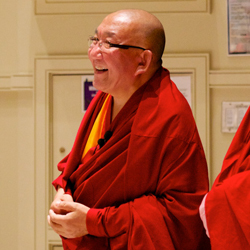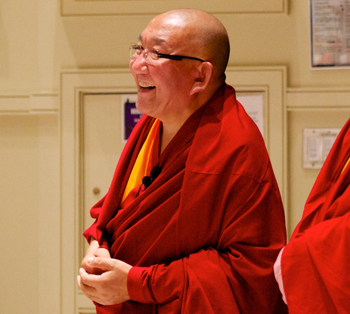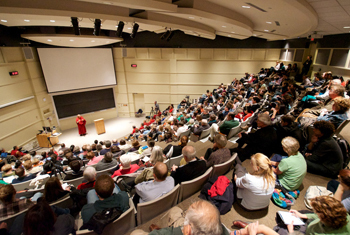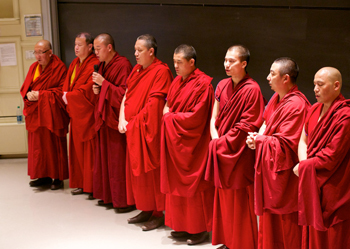

Arjia Rinpoche
A group of Buddhist monks recently visited Notre Dame from November 18-21 to construct a peace sand mandala. As part of their visit, they gave a presentation about the power and practice of compassion called, "Taking in Harshness and Giving out Kindness." The primary presenter, Arjia Rinpoche, director of the Tibetan Mongolian Cultural Center in Bloomington, Ind., was accompanied by seven monks from the Labrang Tashi Kyil Monastery in Dehra Dun, India. The talk was facilitated by Dominic Vachon, director of the Ruth M. Hillebrand Center for Compassionate Care in Medicine and Jan-Li Lin, visiting assistant professor of mathematics.
Vachon explained how Buddhism and other religious traditions have explicitly devoted themselves to practices of cultivating compassion, especially in difficult situations. Learning about these practices can be a catalyst to develop similar practices in medical work in order to maintain compassion toward all types of patients.
“This talk is part of the larger effort of the Hillebrand Center to examine ways health professionals can prepare themselves for the emotional challenges in patient care,” explained Vachon. “Using both scientific findings regarding compassionate care and the accumulated wisdom of the world’s religions, helping professionals learn how to maintain compassion and their morale in the face of suffering and difficulties.”
“Everyone has a seed of compassion, which is love. If something bad happens to a loved one we might cry, be concerned, or worry. However, this type of compassion is very weak because it has an attachment,” said Rinpoche.

Pure compassion is an exceptional kind of love without any condition. Rinpoche described three kinds of relationships one might have – relationships with people we like, with people we do not know, and people we do not like. The purest compassion is demonstrated when one is able to feel it towards the most distant relationships, which would perhaps be towards the people one dislikes. In order to cultivate this type of compassion, one must cultivate aspirational and engaged bodhichitta, the desire to act compassionate towards others. Aspirational bodhichitta is the complete wish to overcome emotional afflictions and delusions to free individuals from suffering. Engaged bodhichitta is engaging in the practices and behavior that help reach this goal, like volunteering for example.
After the presentation, Rinpoche and the seven monks all gathered on stage to provide a moving meditational chant and encouraged the audience to reflect on this practice of cultivating compassion that he just described.
The meditation process starts by preparing oneself to breathe in good qualities and exhale the negative. The cultivation of compassion is then engaged by breathing in all of the negativity of others, imagining this negativity being erased, and sharing all the positivity being exhaled. This process is reflective of the presentation’s title, “Taking in Harshness and Giving out Kindness.” Rinpoche recommended that the audience practice these steps in nine breaths before getting up in the morning.

Meditation and chants
The meditation lasted about ten minutes and consisted of deep throat-singing performed by the monks, a specialized form of chanting in which the individual can produce multiple distinct pitches simultaneously.
Rinpoche, originally from Amdo, Tibet in the Qinghai province of China, became a monk at the age of two in the Kumbum Monastery in Tibet. China’s Cultural Revolution began in 1965 and Rinpoche and every other monk in the country were persecuted during this period. After 16 years of labor camp, he finally was allowed to return to the monastery and resume as a monk. In 1998, due to the strained political climate in Tibet, Rinpoche went into exile because he would not compromise his spiritual beliefs and practices. He then moved to Guatemala for a couple of months and eventually came to the United States. After arriving in the U.S., the Dalai Lama appointed him to be the director of the Tibetan Mongolian Buddhist Cultural Center where he still lives and works today.